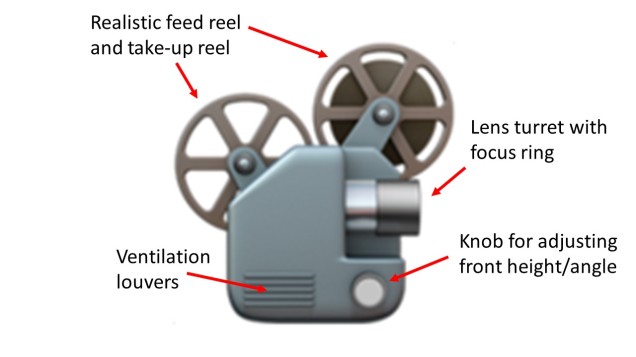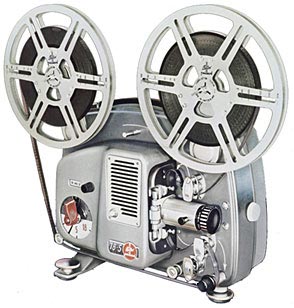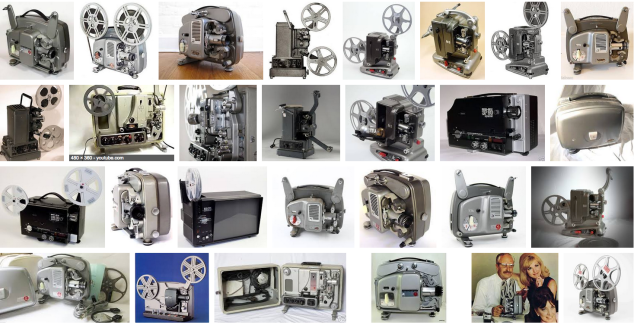OK, I’ll admit it; I’m a middle-aged person who loves using emoji. It tickles me to string them together like one of those endless German compound nouns to convey to my spouse the happy news that our cat pooped inside the litter box this morning, instead of right next to it, as she frequently likes to do for mysterious kitty reasons of her own. (I rendered that as 😼💩📥🎉, in case you were wondering.)
But I’m also a media archivist who gets really 😡 at representations of film and video technology that betray a profound ignorance of the actual objects and devices they’re standing in for. Case in point: good ol’ Unicode symbol number 2175, the film projector emoji. Where do I even begin with how much wrong is packed into this little bundle of pixels? Well, first, let’s look at it in context, as part of the “light & video” symbol cluster:

This grouping is actually quite lovely and poetic, I think. From the red paper lantern and the candle to the still camera with flash and the movie camera, it encapsulates a thousand-plus years of human experimentation with light as a technology and a tool, light as a force we’ve harnessed and made portable and learned to write with. It’s a cluster of symbols that tells a story about how we gradually gained our independence from the coming and going of the sun, and began to cast and keep our own shadows. That’s decidedly headier stuff than my litter-box news flash.
Taken individually, though, some of the little dingbats in this category get my dander up. They’re off — in much the same way that Dürer’s rhinoceros is off: they seem to have been rendered by someone who’s, like, totally heard of that thing they’re drawing. Maybe they even saw a picture of one at some point, a while back. But they sure as shootin’ never saw or touched one in person!

(If you can’t remember what a rhino really looks like offhand, either, look here.) Rhinos may have themselves some ashy knees, but they don’t have actual SCALES. There are similarly serious anatomical anomalies present in the movie camera, film frames, and video camera emoji. I can’t fix every one of the world’s problems, so I just fixate on the film projector.
First and foremost, there are marked differences between each of the variants. One or two of them seem to be at least vaguely informed by the aesthetic of late-mid-century 8mm projector models. Others look more like someone just hot-glued a couple of film reels onto a VHS camcorder and said “Ta-da! Behold, a film projector!” (Yeah, I’m looking at you, Twitter.) That’s like me putting a lampshade on my head and saying “Hey, everybody, look, I’m a lamp!” Not a single one of them appears to have been drawn from observation, and none of them would actually work.
The one that comes closest is the Apple version featured at the top of this post, which kinda-sorta, in a five-beers-into-an-evening-and-feeling-magnanimous way, looks like a Bolex 18-5 regular 8mm projector.
As the Airstream Bambi is to recreational vehicles, so the classic Bolex “toaster” is to domestic film projectors: Born in 1961, round, smooth, shiny, silver, and OMG totes adorbs!

(This lady knows what I’m talking about. She gets it.)
Let’s compare them and talk, first, about what this emoji DOES get right, because I am into positivity:

It’s…not terrible. The feed and take-up reels are the most realistic-looking of any of the emoji projector icons. The feed reel even has something that resembles film on it! The lens is pointed in the right direction, if you’re assuming this is the side of the projector that the operator stands on. The focus ring is the proper cylindrical shape, too, not flared like the lens hood on a camera (as literally all the other versions have it). There are some flourishes like the height adjustment knob that really help sell this icon as being anatomically correct to a passing glance, too.

But compare it with a real Bolex, like the one above, and it’s easy to see that this emoji projector couldn’t possibly work! For one thing, the reel arms are ON THE WRONG SIDE. There is no way that film traveling from the feed reel to the take-up reel would pass between the lamp and the lens on the emoji machine as illustrated. The ventilation louvers would be on the TOP, adjacent to or above the lamp housing (which is absent here), not below it, because…duh, heat rises. The proportions are pretty off, too; the projector body is nowhere near the size it would need to be to house the drive motor and lamp. Lastly, how is there a height adjustment knob and a focus ring, but no on/off switch? What do you run this thing with, The Smart Clapper?
With the possible exception of the Facebook and WhatsApp projector emoji, which get an honorable mention for actually showing — correctly! — the film traveling from feed reel to take-up, all the other emoji projector icons are even more preposterous. All but the WhatsApp one inexplicably depict the take-up reel as being smaller than the feed reel. While it is physically possible to put a takeup reel on your projector that’s smaller than your feed reel, any projectionist will tell you that’s a great way to end up with your last couple hundred feet of film tangled up on the floor. Some of them have the reels just sort of floating in the air, not attached to anything; the ones that have visible arms are at weird angles, and wouldn’t fold in to be flush with the projector body. The EmojiOne and Samsung versions really look like camcorders — not film devices at all, but video ones. (The Samsung reels look suspiciously like EAIJ open-reel video carriers, not film reels, too.) On the EmojiOne and Microsoft icons, the feed and takeup reels actually overlap. At best, they would grind together as the projector ran, which is horrible to contemplate. As to the Google one…not only is it outlandishly proportioned, with an enormous flared lens hood that’s as big around as the larger of the two reels bizarrely floating atop it, like slices of lemon on the edge of a glass of iced tea, but the poor thing is facing the wrong way.
Why do these persnickety critiques matter? Well, for one thing, they tell me the same thing that Dürer’s rhino does: That the person creating this image has never looked closely at one of these creatures in real life. (If we look at the plant or animal emoji clusters or even the food icons in a few years, will those be unrecognizable, too, thanks to accelerating extinction, or a population-wide transition to Soylent-based diets?)
It also affirms that there is a growing distance between analog and digital technologies — one which sometimes leads the latter to make superficial representations of the former. Often, this is in the spirit of homage, or it comes from a desire for footage to “look old” again after archivists have lovingly cleaned and restored it to its best possible state. Other times, it just seems random or lazy. (I loved, and recommend to your attention, Ashley Blewer’s close read of the fake media glitches in Beyoncé’s Formation video.) But while Dürer lacked meaningful access to the exotic creatures of his time, we live in a much more connected age — emoji designers should be able to find plenty of pictures of film projectors to study, even if they don’t have a friendly film archivist near them who can lend them a life model. If you’re an illustrator who wants to help me right this wrong, drop me a line! I’ll hook you up with some beautiful, functional gear to render truthful likenesses from, and we’ll heal this small broken piece of the symbolic world.


